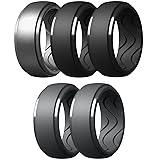All Categories


Crescent External Retaining Ring, Tapered Section, Radial Assembly, 1060-1090 Carbon Steel, Zinc Yellow Chromate Plated Finish, 7/8" Shaft Diameter, 0.042" Thick, Made in US (Pack of 10)
Share Tweet








Crescent External Retaining Ring, Tapered Features
-
Crescent shape creates a low-profile shoulder for applications where clearance is at a minimum
-
Tapered section construction provides flexibility to facilitate installation
-
Ring installs radially by sliding onto the shaft from the side
-
1060-1090 carbon steel is often used in applications where strength is the primary consideration, and the zinc yellow chromate plating offers good corrosion resistance
-
Made in USA
About Crescent External Retaining Ring, Tapered
The crescent external retaining ring has a tapered section, assembles radially, is made of zinc yellow chromate plated 1060-1090 carbon steel, and is made in USA. The ring's crescent shape creates a low-profile shoulder and is recommended for applications where clearance is at a minimum. The tapered section style provides the ring with flexibility to facilitate installation and typically withstands higher thrust loads than constant section and spiral rings. The ring installs by sliding it onto a shaft from the side, also called radial assembly. Often used when the shaft end is not reachable, radial assembly rings enable quicker installation than axially installed rings but may require deeper grooves. The 1060-1090 carbon steel is often used in applications where strength is the primary consideration, and the zinc yellow chromate plating offers good corrosion resistance. Retaining rings attach to a shaft (external) or install in a bore (internal), creating a shoulder to maintain component positioning within an assembly. While most rings install into a machined groove either on the inside or outside diameter of a shaft, self-locking rings attach to a shaft by using friction from means such as teeth and notches to maintain placement. Retaining rings should fit tightly enough into the groove or onto the shaft so they won't experience any movement.
























